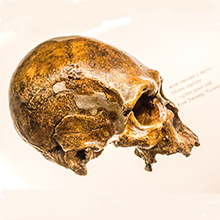Who Were the Ancestors of the Neanderthals?

The Neanderthals are probably our most famous cousins: short, stocky humans who went extinct around 40,000 years ago, with some surprising theories as to why. Less-well known but equally relevant are the Denisovans. Remains were discovered in Denisova Cave (also called Aju-Tasch) in Russia in 2008, and genetic analysis revealed them to be very close relatives of Neanderthals. Closer than us, in fact. It turned out we had not one, but two closest relatives.
But who were the hominins that gave rise to the Neanderthals and the Denisovans? University of Utah anthropologist Alan Rogers, who specializes in population genetics and evolutionary ecology, has been working on this problem for over a decade. But a paper he published in 2017 in the Proceedings of the National Academy of Sciences (PNAS) led him down a new, unexpected course.
